A timeline of important events in paleontology : 19th Century
1800: William Smith developed the principle of faunal succession from his studies of stratigraphy in England. (EvoWiki)
1800: Georges Cuvier argues that fossils represent extinct species of living things. (EvoWiki)

1801: exhumation of a mastodon at artist/scientist Charles Willson Peale's Barber Farm Mastodon Exhumation Site, near Montgomery, New York, claimed to be the first articulated prehistoric skeleton. Wikipedia
1801: French botanist Augustin Augier publishes the first branching (tree) diagram
1802: William Paley publishes Natural Theology which uses the watchmaker analogy to argue for the existence of God from signs of intelligent design in the living world. (Wikipedia)
1809: William Maclure conducts the first geological survey of the eastern United States. (Wikipedia - Timeline of Geology)
1809: Jean-Baptiste Lamarck publishes his Philosophie Zoologique, one of the first systematic attempts at a theory of evolution. Although he did not believe all living things shared a common ancestor, he did believe they formed evolutionary gradients (EvoWiki). Lamarck believed that an innate life force drove species to become more complex over time, advancing up a linear ladder of complexity that was related to the great chain of being. Lamarck argued that changes in an organism would be inherited by the next generation and produce slow adaptation to the environment. It was this secondary mechanism of adaptation through the inheritance of acquired characteristics that would become known as Lamarckism and would influence discussions of evolution into the 20th century.
A radical British school of comparative anatomy that included the anatomist Robert Grant was closely in touch with Lamarck's French school of Transformationism. One of the French scientists who influenced Grant was the anatomist Étienne Geoffroy Saint-Hilaire, whose ideas on the unity of various animal body plans and the homology of certain anatomical structures would be widely influential and lead to intense debate with his colleague Georges Cuvier. Grant became an authority on the anatomy and reproduction of marine invertebrates. He developed Lamarck's and Erasmus Darwin's ideas of transmutation and evolutionism, and investigated homology, even proposing that plants and animals had a common evolutionary starting point. As a young student Charles Darwin joined Grant in investigations of the life cycle of marine animals. In 1826 an anonymous paper, probably written by Robert Jameson, praised Lamarck for explaining how higher animals had "evolved" from the simplest worms; this was the first use of the word "evolved" in a modern sense. (Wikipedia)
1811: (or one or two years earlier?) Mary Anning and her brother Joseph unearthed the skull and skeleton of a 5.2 meter long animal at Lyme Regis. It would later be named Ichthyosaurus (now classified as Temnodontosaurus platyodon), which helped popularise the idea of extinct saurians
1813: Cuvier publishes An Essay on the Theory of the Earth, considered the first major breakthrough in biostratigraphy (EvoWiki).
1815: William Smith published The Map that Changed the World, the first geologic map of England, Wales, and southern Scotland.. (Wikipedia - Timeline of Paleontology)
1818: The first material attributed formally to a dinosaur is recovered from near Oxfordshire, England by William Buckland (EvoWiki).
1821: William Buckland finds the remains of a hyenas' den in Yorkshire, containing the bones of lions, elephants and rhinoceros.. (Wikipedia - Timeline of Paleontology)
1821: Henry De la Beche and William Conybeare write the first scientific description of the Ichthyosaurus (Notice of the discovery of a new Fossil Animal, forming a link between the Ichthyosaurus and Crocodile, together -with general remarks on the Osteology of the Ichthyosaurus). The Plesiosaurus was descrined in the same paper.
1821-1822: Mary Anning discovers the world's first Plesiosaur skeleton at Lyme Regis.. (Wikipedia - Timeline of Paleontology)
1822: Gideon Mantell discovers the fossilized skeleton of an Iguanodon dinosaur. (Wikipedia - Timeline of Paleontology)
1823: Human bones are found with those of the woolly mammoth at Paviland Cave on the Gower Peninsula, proving that the two had lived on earth at the same time.. (Wikipedia - Timeline of Paleontology)
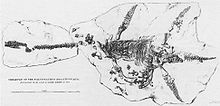
1823: Mary Anning discovers a nearly complete Plesiosaurus dolichodeirus skeleton.
1824: The first dinosaur taxon, Megalosaurus, is described, by William Buckland (EvoWiki).
1829: description of the huge Pliocene proboscidean Deinotherium giganteum by German naturalist Johann Jakob Kaup. In 1836 an entire skull, was found in the Lower Pliocene beds of Eppelsheim, Hesse-Darmstadt, indicating an animal exceeding modern elephants in size.
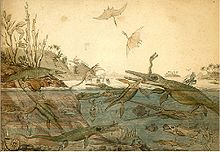
1830: Duria Antiquior - A more Ancient Dorset, watercolour painted by geologist Henry De la Beche based on fossils found by Mary Anning; the first pictorial representation of a scene from deep time based on fossil evidence.
1830 - 1833: Sir Charles Lyell (student of Buckland) publishes his Principles of Geology, wherein he formulates uniformitarianism and refutes catastrophism, and describes the world as being several hundred million years old. (EvoWiki, Wikipedia - Timeline of Geology).
1831: Charles Darwin departs on his voyage on the Beagle (EvoWiki).
1836: American geologist Edward Hitchcock describes the footprints of giant birds from Jurassic formations in Connecticut. (Wikipedia - Timeline of Paleontology)
1836: William Buckland, theologian and geologist, publishes Geological and Mineralogical Considerations with Reference to Natural Theology which was sixth in the Bridgewater Treatises series and rejected a global flood. (Wikipedia)
1837: Louis Agassiz begins his glaciation studies which eventually demonstrate that the Earth has had at least one ice age. (Wikipedia - Timeline of Geology)
1838: Charles Darwin formulates the theory of natural selection (EvoWiki).
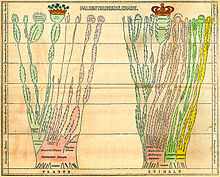
Fold-out paleontological chart of Edward Hitchcock in 'Elementary Geology' (1840). It shows two trees: one for plants, one for animals. This 'tree of life' is the earliest known version that incorporates paleontological and geological information. However, unlike the later trees of Haeckel, Hitchcock did not intend this to erepresent a naturalistic theory of evolution. Wikipedia; Public Domain) |
1840: Edward Hitchcock publishes the first Tree of Life based on paleontology. It shows a branching diagram of the plant and animal kingdom against a geological background (the vertical axis). He referred to it as a tree. However, it is not a true evolutionary tree of life, because Hitchcock saw a Deity as the agent of change (Wikipedia)
1841: August Breithaupt, Vollstandiges Handbuch der Mineralogie. (Wikipedia - Timeline of Geology)
1842: Richard Owen applies the name Dinosauria to a group of extinct Mesozoic reptiles (EvoWiki).
1844: Charles Darwin writes his unpublished Essay on evolution by natural selection (EvoWiki).
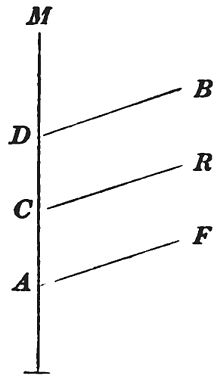
Diagram from Vestiges of the Natural History of Creation (1844) by Robert Chambers shows a model of development where fish (F), reptiles (R), and birds (B) represent branches from a path leading to mammals (M). Wikipedia; Public Domain) |
1844: Scottish publisher Robert Chambers anonymously published an extremely controversial but widely read book entitled Vestiges of the Natural History of Creation. This book proposed an evolutionary scenario for the origins of the Solar System and life on Earth. It claimed that the fossil record showed a progressive ascent of animals with current animals being branches off a main line that leads progressively to humanity. It implied that the transmutations lead to the unfolding of a preordained plan that had been woven into the laws that governed the universe. In this sense it was less completely materialistic than the ideas of radicals like Robert Grant, but its implication that humans were only the last step in the ascent of animal life incensed many conservative thinkers. The high profile of the public debate over Vestiges, with its depiction of evolution as a progressive process, would greatly influence the perception of Darwin's theory a decade later.(Wikipedia)
1848: James Dwight Dana, Manual of Mineralogy. (Wikipedia - Timeline of Geology)
1851: Carl Jacob Sundevall is among the first to propose that myology might be useful in understanding avian relationships (EvoWiki).
1854: Alfred Russel Wallace departs for the Malay Archipelago (EvoWiki).

Woodcut of the famous banquet in Benjamin Waterhouse Hawkins' standing Crystal Palace Iguanodon, New Year's Eve 1853. Wikipedia; Public Domain) |
1854: Unveiling of the Crystal Palace Dinosaurs, a series of sculptures of dinosaurs and extinct mammals located in Crystal Palace, London. Commissioned in 1852 and unveiled in 1854, they were the first dinosaur sculptures in the world, pre-dating the publication of Charles Darwin's On the Origin of Species by six years. Designed and sculpted by Benjamin Waterhouse Hawkins under the guidance of Richard Owen (Wikipedia)
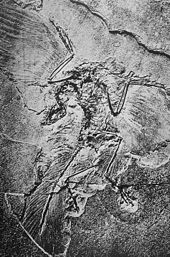
1855: The first Archaeopteryx fossil found in Bavaria, Germany. (Wikipedia - Timeline of Paleontology)
1856: Neanderthal man (Homo neanderthalensis holotype) discovered by Johann Fuhlrott in the Neander Valley, Germany (EvoWiki).
1857: Philip Henry Gosse published Omphalos: An Attempt to Untie the Geological Knot. Omphalos is Greek for "navel". Gosse was a brilliant naturalist who invented the first stable seawater aquarium. Gosse's book was an attempt to reconcile biblical literalism with geological uniformitarianism by adopting a Surrealist or Surrogate Realist (an anti commonsense realist) view of uniformitarianism and science generally. The book's Surrealist interpretation of science can be summed up God created the world as if the teachings of geology & science are true. Gosse's position is sometimes referred to as "Theological Surrealism" (see Jarrett Lepin for less trivial examples of Surrealism). Gosse's theme within the book was whether Adam and Eve had belly buttons (remnants of a link between the placenta and the baby). Since Adam and Eve did not have human parents they should not have belly buttons. This theme underlies the tension between geological records and biblical fundamentalism. His book was rejected by both sides of the debate because it "cuts no ice". Much of 21st century Creationist, Intelligent Design Theories flirt with Gosse's surrealist tenets to create an alternative and competing science. (Wikipedia)
1858: Charles Darwin and Alfred Russel Wallace publish a joint paper on natural selection (EvoWiki).
1858: The first first dinosaur skeleton was discovered, in marl pits in the small town of Haddonfield, New Jersey (although fossils had been found before, their nature had not been correctly discerned). It was described by Joseph Leidy, who named the creature was named Hadrosaurus foulkii, and realised it to be clearly a bipedal creature, in contrqast to the quadrapedal and incorrect Crystal Palace Dinosaurs. (Wikipedia - Dinosaur)
1859: Charles Darwin published The Origin of Species regarding the theory of evolution, after over 20 years of research and discovery.. The printing sells out on the first day. Darwin was prompted to publish by the publication of an essay by Alfred Russel Wallace, which independently summarized the theory. The theory's most profound element, "natural selection," challenged the generally accepted idea of divine intervention in species formation, leading to strong reaction to Darwin's theory. (Wikipedia)
1860: Liberal theologians published Essays and Reviews supporting Darwin. A debate of Darwin's theory was arranged at the Oxford Museum, with Thomas Huxley among its defenders and Samuel Wilberforce, the Bishop of Oxford leading its critics. Later accounts indicate Sir Joseph Hooker was most vocal in defending Darwinism. (Wikipedia).
1861: The London Archaeopteryx specimen is discovered in Germany (EvoWiki).
1862: Lord Kelvin attempts to find the age of the Earth by examining its cooling time and estimates that the Earth is between 20—400 million years old. (Wikipedia - Timeline of Geology)
1862: Henry Bates describes Batesian mimicry using coloring on butterflies (EvoWiki).
1865: Gregor Mendel publishes his primary research on inheritance (EvoWiki).
1866: Ernst Haeckel's Generelle Morphologie der Organismen forms the foundation for evolutionary systematics, phylogeny, embryology, and more. Haeckel's work essentially integrates Naturphilosophie and Darwinism.
1867: Thomas H. Huxley publishes the first major classification of the class Aves since the work of Spencer Fullerton Baird (1858), using the morphology of the sternum and palatal configuration as key characters for understanding avian relationships (EvoWiki).
1868: Thomas H. Huxley proposes the theropod ancestry of birds (EvoWiki).
1869: Joseph Lockyer starts the scientific journal Nature. (Wikipedia - Timeline of Paleontology)
1871: Othniel Charles Marsh discovers the first American pterosaur fossils.. (Wikipedia - Timeline of Paleontology)
1877: The Berlin Archaeopteryx is described (EvoWiki).
1878: The first Diplodocus skeleton is found at Como Bluff, Wyoming. (Wikipedia - Timeline of Paleontology)

The Tree of Life as seen by Ernst Haeckel in The Evolution of Man (1879). Haeckel was an atheistic philosopher and scientist and staunch supporter of Darwinism and naturalistic theories of evolution. Diagram from Wikipedia; Public Domain |
1879: Ernst Haeckel's famous illustration published in The Evolution of Man, which shows a Great Chain of Being model with Homo sapiens at the top. Although this would seem an anthropocentric step backwards in relation to his earlier but more contemporary-looking three-kingdom model, it should be remembered that for Haeckel, as for many 19th century evolutionists, humans were considered the pinnacle of evolution. Teilhard de Chardin serves as an early 20th century example.
1884: Marcel Alexandre Bertrand, Nappe and Thrust fault theory. (Wikipedia - Timeline of Geology)
1891: Haeckel's student Eugene Dubois discovers Pithecanthropus (now known as Homo erectus) specimen on the Indonesian island of Java ("Java Man") (EvoWiki).
content by MAK110418, 111205, with material from Wikipedia.







